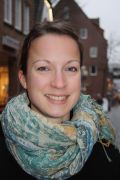The Culture of Yorkshire Pudding
Food is such an integral part of culture, and is often where thoughts turn when thinking of travel.

Coeliac disease is invisible to any onlooker, but affects those inflicted with the condition on a daily basis, and in manifold ways. A photography project I have been involved with aims to challenge typical perceptions of what constitutes health, and draw attention to the diversity behind the terms illness and disability. In the case of ‘invisible’ disabilities such as coeliac disease, it is often a matter of actively claiming the term disability (or chronic illness) for oneself. Those living with such less obvious conditions regularly find themselves in situations, both in public and private, in which they must decide whether, and how, to share the information, and thus ‘come out’ with their ailment.
In a society in which presumed health is still the norm, sharing a less perfect story involves taking risks. Self- and externally determined image may clash in the moment of narration, and one becomes particularly vulnerable exposing less apparent facets of one’s identity. Often the ill person must be prepared for judgment. In an ableist environment, authenticity as well as the motives for ‘coming out’ with illness or disability may be questioned. A voyeuristic audience may find pleasure in regarding the ill as the ultimate ‘other’ – being equally intrigued as repulsed. Despite the risk of navel-gazing, I believe it is only by taking their story into the public realm that those with hidden illnesses can establish lasting, individual connections with others, as well as change wider societal perceptions of illness and/or disability. Sharing illness therefore is a political, even ethical, act as much as it is one of personal importance. Therefore I do not think it is surprising that there are more and more blogs around doing exactly that: sharing people’s stories, using blog posts and forums as spaces in which to discuss common misconceptions or to give practical advice, to spread information, and to address and discuss more subtle issues of self-representation. And sometimes, writing for or visiting a site simply helps to cope on a bad day.
The project from which the above image is taken is loosely related to my PhD work in which I investigate autobiographical German illness narratives. All of the texts in my corpus have been published between 2007 and 2013, some by prolific and acclaimed authors, others by first-time writers. They tell of living through or living with a diverse range of experiences: breast cancer, trauma, aphasia, a brain tumor, a liver transplant or lung cancer which has given the authors’ lives, and their writing, a new perspective. Motivated by this notable new wave of autobiographical writing on trauma, illness and death, my PhD thesis on contemporary German-language literature takes a major interest in how the authors of autobiographically inspired illness narratives anticipate and deal with reactions by the media and the reading public, both within and beyond their texts. I analyse narrative strategies, aesthetic forms and publication media that are employed in this kind of life writing as much as that I focus on the unique context in which each of the narratives has been published. Furthermore I take care to pay attention to the reception they have received.
In the process of collaboration with photographer Andy Brown, the element of invisibility that is inherent to certain conditions crystallised as the one we wanted to focus on. Our aim was to problematise this aspect in a triptych of photos, whilst acknowledging the paradox of taking images of something that is invisible to the naked eye. For me, what started as a public engagement project and purely ‘academic exercise’ soon became an autobiographical experiment in sharing my very own, invisible chronic illness. Exposing my navel poster-size as one result of this project, I have gained a deeper understanding of what it might mean to be in my authors’ shoes whose books and whose bravery I have come to appreciate more and more.
Photo by Andy Brown (http://www.envioustime.co.uk/)
To see all of the images and learn more about the engagement project ‘The Image Speaks’ that my collaboration with Andy Brown was a part of, follow this link:
http://on.fb.me/1lxmpky

This post was written by Nina
This post was written by Kati’s sister. Nina was diagnosed with coeliac disease in 2009 – partly thanks to Kati’s diagnosis the year before. She currently lives in Sheffield, UK, and does a PhD in contemporary German literature at The University of Sheffield.
Are you interested in writing a post on Glutenfreiheit as well? Get in contact with us and we'll get you published here!
Food is such an integral part of culture, and is often where thoughts turn when thinking of travel.
Write comment